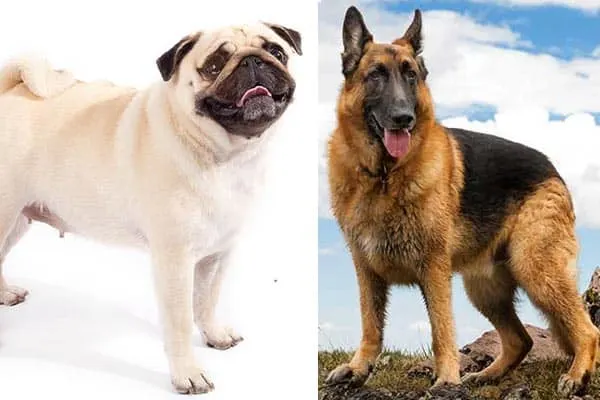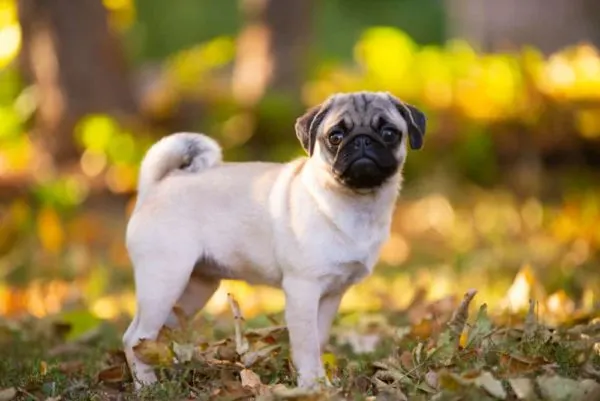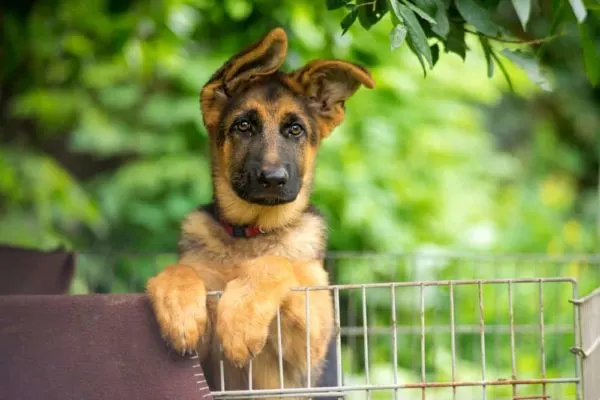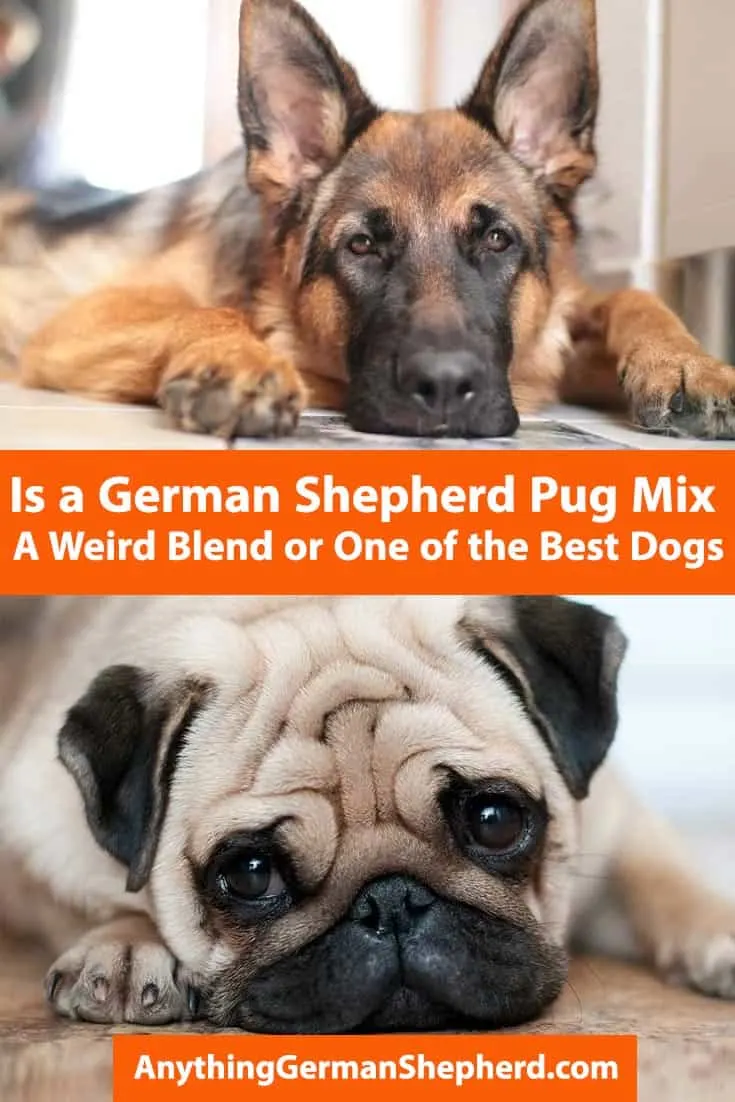Is a German Shepherd Pug Mix a Weird Blend or One of the Best Dogs?
Of the top 30 most popular dogs, which do you think is the most adorable?
Although you may prefer a more elegant and noble dog like a German Shepherd, few can deny the appeal of a Pug or French Bulldog.
Although genetics can be a somewhat unpredictable venture, a German Shepherd Pug mix would likely improve on a few traits of each of the purebred dogs.
Not only are Pugs small, ideal for apartment living, but they are bubbly and cuddly, not likely to appear on anyone’s dangerous dog list.
Plus, your DNA programs you to love small warm furballs with relatively large heads, round eyes, and flat faces.
What if you could combine the best traits of the Pug with the desirable athleticism and work ethic of the German Shepherd?
Would you be able to get a cute and friendly dog with a healthier muzzle and leg length than the Pug?

German Shepherd Pug Mix: Two Dogs From Vastly Different Backgrounds
German Shepherds have a rich working heritage, first as herders and protectors of livestock and later as police and war dogs, guide dogs, search and rescue animals, and guard dogs.
Max Stephanitz discovered his ideal working dog model in 1899 in a GSD Hektor who soon became Horand.
Stephanitz developed the breed further through closely-related offspring such as Beowulf and herding dogs tending sheep across the plains of Germany.
Even before Stephanitz’s early work, historians believe the first German Shepherds like Horand may have been able to trace their ancestral tree to mountain dogs from 7000 A.D.
The Pug is among the most ancient of dog breeds. Pugs roamed China as early as the Han Dynasty, which spanned from 200 B.C. to 200 A.D.
However, evidence suggests an earlier foundation for the breed in the Lo-Sze Dog of 700 B.C.
The Pug illustrates to perfection the phrase, “She never worked a day in her life.” From their origins, Pugs have always been solely companion dogs despite a possible common ancestry with the Tibetan Mastiff.
Not only have Pugs served as loyal companions their entire history, but they also once almost exclusively accompanied royalty.
Persons of the crown would display a special preference for the little dogs for decades to come.
Pugs found their way to Europe in the 1500s and 1600s, and gained overwhelming popularity along with other purebred dogs during the Victorian Age when they shared the spotlight with the Poodle and German Shepherd.
They had short coats, so while Victorians could not figure out an attractive haircut for Pugs, they dressed the dogs in elaborate collars and bows around their necks.
What physical characteristics does your ‘Shug’ stand to inherit?
Like many German-Shepherd-based designer dogs, such as the Shottie or Doberman Shepherd, the Shug often has a readily recognizable appearance and demeanor.
However, the two parent breeds are so different you can obtain widely different variations that can resemble a rare breed or one of the purebred parents.
How big will your dog be?
German Shepherds are two feet tall at the shoulders, give or take a couple of inches. Females tend to be slightly shorter than males.
The AKC does not specify a weight standard, but most Shepherds are between 65 and 90 pounds.
Contrast the Shepherd with the Pug, who stands 10 to 12 inches tall and weighs 15 to 18 pounds. In fact, Pugs belong to the AKC’s toy group. Females are slightly smaller than males.
Shugs are usually of a size between their parents. They can range from the upper height of the Pug at 12 inches to significantly shorter than a Shepherd at 15 inches tall.
Most Shepherd Pug hybrids weigh 45 to 50 pounds, making them medium-sized dogs.
What color will your German Shepherd Pug mix be?
A Shepherd’s color can range from black and tan to red and tan to solid blue, black, red, white, or sable. He can have black markings from a saddle pattern to most of his body.
Pugs are most commonly fawn with a distinctive black mask, but Lady Brassey popularized solid black Pugs around 1886 and they have seen a recent resurgence.
With the coloration selection from their parents, Shugs can be black and tan patterned like a Shepherd, or the colors may be marbled. They are more often fawn, like Pugs.
Other possibilities are silver fawn, solid black, or brindle.
What other traits should you look for besides color and size?
Shepherds are medium-large dogs with a rectangular moderately sloping topline from shoulders to croup. Ideally, they should have a length to height ratio of 10 to 8 or 8.5.
The German Shepherd has a low-slung, relatively long, somewhat bushy tail that curves slightly upward at the end.
German Shepherds have a long moderately narrow snout with powerful jaws and tight lips. The shoulders and neck are long, facilitating an effortless and efficient stride, especially when trotting.
Shepherds move with grace and speed, showing off their specialty as working dogs. They have deep chests that facilitate enhanced cardiac function and stamina.
A German Shepherd’s head further demonstrates the dog’s noble carriage, slightly domed from muzzle to the forehead and sporting two large open and erect ears.
The Shepherd’s eyes are brown, intelligent, and unwavering.
Pugs are tiny with a compact build that should never appear lean. They have a curly tail that frequently has two or more spirals.
Their ears are medium and somewhat forward-facing as they lay against their round heads. Pugs have an extremely short muzzle with wrinkles considered good luck by the Chinese and round bulging eyes.
It is difficult to say what their paws will be like, given the major differences in size and appearance between the two dogs.
A Shug will likely not appear as stocky or rotund as a Pug but will have more of a square conformation than a Shepherd.
The hybrid usually has semi-prick button ears similar to a Pit Bull. Some have ears that hang against the head like a Pug’s while a few have rather small triangular pinnae that are upright like a Shepherd’s.
Shugs usually have a broad and deep chest like a Shepherd and a shortened muzzles with neither the flat-faced exaggeration nor the facial folds of the Pug. Their eyes are round with varying degrees of bugging.

Temperaments of Shugs vary more than their looks
Does Shugs make great guard dogs?
While a Shepherd Pug mix will not likely guard your property very well, they tend to warn against intruders.
Although friendly and not typically aggressive, a Shug dog’s sharp bark is enough of a deterrent to prevent most criminal intent.
Socialization is crucial for Shugs to keep them from developing fearfulness or shyness.
Are German Shepherd Pug hybrids good family dogs?
Shugs who inherit a balanced blend of genes from their parents make excellent family companions. They are happy, friendly, loyal, and eager to please and entertain.
Hybrids may inherit temperament and personality traits to varying degrees and thus, your Shug can gain any mix of tenaciousness, focus, and courage from the Shepherd and charm, humor, and gentleness from the Pug.
Will your dog be good around children?
German Shepherds often must receive training as well as socialization to be safe around children.
Although Shepherds do not target kids for misplaced aggression, they can become irritable with teasing and maybe on guard against unfamiliar young people.
Pugs enjoy everyone, including children. To a Pug, a child is another person who can touch and love on her.
The Shug usually is very tolerant of and even affectionate with children.
Although it is not advisable to leave dogs unsupervised with toddlers and infants, the Shepherd Pug mix seems to thrive around people of any age.
Will your Shug tolerate your guests?
Shepherd-Pugs are usually friendly and outgoing with strangers. A dog who inherits more of his personality from the German Shepherd may be indifferent or somewhat aloof with your guests.
However, a well-socialized Shug dog is neither aggressive nor fearful.
What about other pets?
Historians and behaviorists alike, according to Petplace.com, classify the herding instinct as a modification of a strong predatory drive.
German Shepherds tend to chase small animals, although, with proper training, they can learn to get along with cats and small dogs. Some individuals do better with other animals than others.
German Shepherds may also have issues with dogs their size because they generally learned to work independently as opposed to hounds who work in packs.
Moreover, the Shepherd has a history that includes some dogfighting. Males tend to be more dog aggressive than females, but same-sex aggression with either gender is not uncommon.
It is a Pug’s nature to get along with everyone as long as they do not ignore her.
Shugs usually get along well with other dogs. It is always a great idea to socialize your puppy at a young age, so she does not grow up shy and suspicious around other canids.
A Shepherd Pug mix can, however, inherit a moderate prey drive from the GSD. The most effective way to deal with dogs who have the temptation to chase small animals is to train unquestioning obedience.
How easy are Shugs to train?
According to Apa.org, the top 20 percent of dogs are Border Collies, Poodles, German Shepherds, Golden and Labrador Retrievers, and Dobermans.
Stanley Coren, a renowned psychologist, ranks dogs similarly and according to three intelligence categories.
Based on instinctual intelligence, adaptive learning, and obedience, Coren places German Shepherds No. 3 and Pugs No. 108 out of 138 breeds of dogs.
Both the Shepherd and the Pug can pose challenges with training. Shepherds sometimes exhibit dominance and pushiness, while Pugs often demonstrate willfulness and an inability to focus.
Pugs are reputably difficult to house train.
A Shepherd Pug mix is generally not problematic to train, albeit not as readily obedient as a GSD. They possess intelligence inherited from the Shepherd but can acquire some stubbornness from the Pug.
Shugs require persistent training and exposure to consistent mental stimulation. Boredom can cause them to be destructive like the Shepherd, digging, chewing, and barking.
The Shepherd Pug hybrid also needs constant human companionship like his Pug parent and will react with depression if left on his own.
How much exercise does your dog need?
Pugs are enthusiastic but fairly sedentary dogs.
Their snub noses create a plethora of problems collectively called brachycephalic syndrome that causes exercise to be uncomfortable and, in some cases, life-threatening.
Brachycephalic complications stem mostly from trouble breathing.
- Stenotic nares – Despite the dog’s large relative head size, his nostrils are small. Narrow or stenotic nares increases resistance to drawing air into the sinuses.
- Elongated soft palate – Behind the ridges on the roof of the mouth is a flat area going towards the throat that is called the soft palate. In Bulldogs, Pugs, and similar dogs, the soft palate often extends past where it normally should and can partially obstruct the epiglottis.
- Hypoplastic trachea – The trachea or windpipe does not fully develop in short-nosed breeds, meaning the tubular structure is narrow and can collapse in some individuals, making it even more difficult for the dog to breathe. Moreover, as the animal finds more difficulty breathing the trachea collapses even more with the effort.
Brachycephalic breeds will easily suffer respiratory distress with heat, stress, or excessive exercise.
Their shortened muzzles also predispose them to heatstroke because their sinuses are not long enough to cool inhaled air.
The exercise requirements of your Shug will vary depending on her conformation.
If your dog has inherited a greatly shortened snout, she will not tolerate as much exercise as a canine with a more normal muzzle.
One way you can tell if your dog potentially suffers from brachycephalic syndrome is frequent snuffling, snorting, reverse sneezing, or loud breathing, also known as stridor.
Your pup may also snore loudly. Dogs who struggle to breathe are inherently exercise-intolerant and brief walks at multiple times during the day are best.
If your dog’s nose is only slightly shorter than a Shepherd’s or medium in length, your dog will require 30 to 45 minutes of exercise daily.
You should mix a brisk walk with 10 to 15 minutes of vigorous activity, like running or romping. You can play fetch or Frisbee. Combine physical exercise with training or interactive mental games.

Shugs do not tolerate temperature extremes at all
The German Shepherd is one of the most weather-resistant dogs you can own.
A Shepherd’s double coat is ideal for cold temperatures and snow, providing warmth and insulation and protection against moisture from ice and snow.
This same double coat provides insulation and exceptional air circulation in the heat.
Although the Pug often has a double coat, it is of rather thin hair. Most black Pugs do not even have an undercoat. A sparse coat alone tells you the Pug probably will not do well when it is cold outside.
Moreover, a Pug’s small size means she has a high surface area to volume ratio, allowing heat to escape readily. You might think, “Well, then, Pugs do great in the heat.”
Pugs perform dismally in hot conditions. Their thin coats do not offer much insulation, and their short sinuses do not cool inhaled air much before it reaches the lungs.
Finally, struggling to breathe and chronic hypoxia are stressors that raise a Pug’s body temperature.
As the Pug’s distress increases, her temperature rises, which further compromises her ability to breathe, setting up a vicious and life-threatening cycle.
Pugs must not venture outside when it is hot, and you must monitor their exercise at all times.
The parent breeds don’t support extreme temperatures, and neither does the mix
Shugs usually fall between the Pug and German Shepherd in snout length and coat.
Therefore, a Shug mix will do moderately better than a Pug in cold weather and will need limitations on activity when it is warm outside.
Look for any signs of respiratory difficulty in your German Shepherd Pug mix or tiring easily during exercise. If your Shug shows any laboring, immediately bring him inside if possible.
If not, cool him down immediately, using water if necessary.
Heat exhaustion and heat stroke require immediate medical attention after you have taken efforts to cool the animal yourself.
Remember, never immerse a heatstroke patient in ice water as it is too shocking to the dog’s system.
Signs of exercise intolerance are obvious, and unlike with other breeds, you should not encourage your Shug to work through it.
- Wants to stop during a walk or sits down
- Lags on the leash
- Breathing becomes louder or dog’s tongue starts to hang out further than usual
Signs of heat exhaustion and heatstroke can be subtle unless you are looking for them. Serious signs tend to appear when the condition is already advanced, according to the RSPCA.
- Heavy panting
- Fatigue and exercise intolerance
- Difficulty breathing – Although many owners accept a certain degree of respiratory difficulty as normal for short-nosed breeds, you should not ignore it in your Shug. Addressing breathing issues early in your dog’s life can lower his susceptibility to heatstroke and prevent chronic hypoxia which will shorten his life.
- Heavy panting – A German Shepherd can pant heavily and be fine. If your Shug is panting heavily, you may have exercised her too hard. It is a sign of heat exhaustion if it is warm out.
- Drooling
- Vomiting or diarrhea
- Bright red mucus membranes
Shugs live as long as Pugs
Despite having similar health problems, Pugs live significantly longer than English Bulldogs. Bulldogs live about seven years with a reported range of 8 to 10, while Pugs have a lifespan of about 12 to 15 years.
They have a few breed-specific health problems in addition to the brachycephalic complex.
- Orthopedic disorders – The Pug is one of the small breeds prone to hip dysplasia as well as Legg-Calves-Perthes disease (the head of the femur dies because the blood supply becomes interrupted) and luxating patellas (kneecaps dislocate during normal movement).
- Entropion – A pug’s facial folds make loose skin around the eyes which can cause the eyelids to roll inward.
- Hemivertebra – Many dwarf dogs with curly or corkscrew tails can have moderate to serve deformities of the vertebrae. The severe case will become paralyzed.
- Pug Dog Encephalitis – Fatal immune-mediated inflammation that affects only Pugs and is hereditary.
- Corneal ulcers and lacerations – Depending upon how fast her face is and how bugged her eyes, a Pug is vulnerable to ocular injury.
- Keratoconjunctivitis sicca – Dry eye.
- Skin and ear infection – Frequently have allergies as a cause.
- Obesity – If a Pug becomes overweight, it exacerbates any breathing difficulties.
German Shepherds live 10 to 12 years
They have several health concerns, most of which have at least one genetic factor.
- Panosteitis – Painful bone inflammation of young growing dogs.
- Bloat – Complex involving gas and fluid distension of the stomach followed by life-threatening rotation; seen in deep-chested usually large breed dogs and Dachshunds.
- Orthopedic – Hip and elbow dysplasia.
- IVDD – Intervertebral disc disease or slipped disc.
- Degenerative myelopathy – Progressive nerve disease eventually leading to paralysis.
- Diabetes – Maybe related to the high incidence of pancreatitis.
- Pannus – Disorder of the cornea common in Shepherds.
- Seizure disorder
- Hemophilia – Bleeding disorder.
Shugs have a similar lifespan to their Pug parents of 12 to 15 years. The hybrid tends to represent a vast improvement in terms of health over both parents.
- Hip dysplasia
- Elbow dysplasia
- Bloat
- Allergies – usually a minor concern with Shugs.
- Brachycephalic syndrome – This is of minor concern to Shug dogs, according to Doggiedesigner.com.
Will your mixed dog shed?
Even though German Shepherds and Pugs shed a lot, Shug dogs exhibit minimal shedding. Their coats require brushing at least weekly to stimulate the skin and remove debris.
Shug dogs should receive infrequent baths. You should check your dog’s ears regularly and trim her nails every month or two.

Frequently Asked Questions
Can a German shepherd mate with a pug?
Yes, a German shepherd dog can mate with a pug and they do exist, they’re referred to as ‘Shugs’. Despite the dimensions of the two dogs being very different, breeding them is possible but only with some help.
The only way for this breed to be created is by the male pug to breed with a female German shepherd.
A female pug carrying a German shepherd mixed breed puppy through the gestation period would be very difficult and highly advised against as it can be uncomfortable for them and can even lead to death.
The breed has a mix of the laid back personality that pugs have, along with the energy of a German shepherd.
They’ll be the perfect companion for hanging around the house but also mixed with the energy of a German shepherd that needs plenty of stimulation and exercise throughout the day.
What does a pug and a German shepherd mix look like?
Just like any other mixed breed, the ‘Shugs’ appearance can vary depending on whether they’ve inherited more of their mum or dad’s genes, sometimes they can be unrecognizable as the mixed-breed ‘shug’.
However, Shugs are commonly a medium-sized breed taking the brown, cream, tan, and black colorings combined of both the parents.
They may even have the marbling effect of colors on their fur like German shepherds do.
They can have floppy ears like a pug or erect ears like a German shepherd and many will have a tail that is more similar to that of a pug, although it’s not uncommon to see shugs with more relaxed fluffy tails like German shepherds.
They’ll have a stocky appearance about them with broad chests with either a short-muzzled snout if it’s taken more of the pug’s genes or a longer one like a German shepherd if it’s inherited those genes.
If the Shug has inherited the longer nose of a German shepherd, then it’ll benefit them as the short snout of a pug can cause bad breathing problems for the breed throughout their life.
Is the German Shepherd Pug mix, or ‘Shug’ your next dog?
A Shug, a mix between a German Shepherd and a Pug, is likely to be a medium-sized fawn dog with a deep chest, semi-pricked ears oriented to the sides, large slightly bugged eyes, and a curled tail.
Shugs have a medium-short moderate double coat and an energetic, friendly, affectionate personality. Despite their vigor, they must have limited exercise depending on their muzzle length.
Shepherd Pug hybrids are easy to train and get along well with children and other dogs.
This dog shows a common result of the Shepherd Pug mix with a broad chest, muscular compact body, curled tail, and rare upright ears.
This is not a moving video but shows the more classic Shug head with semi-prick ears. Note the coloration which is almost a mix between sable and silver fawn.






























